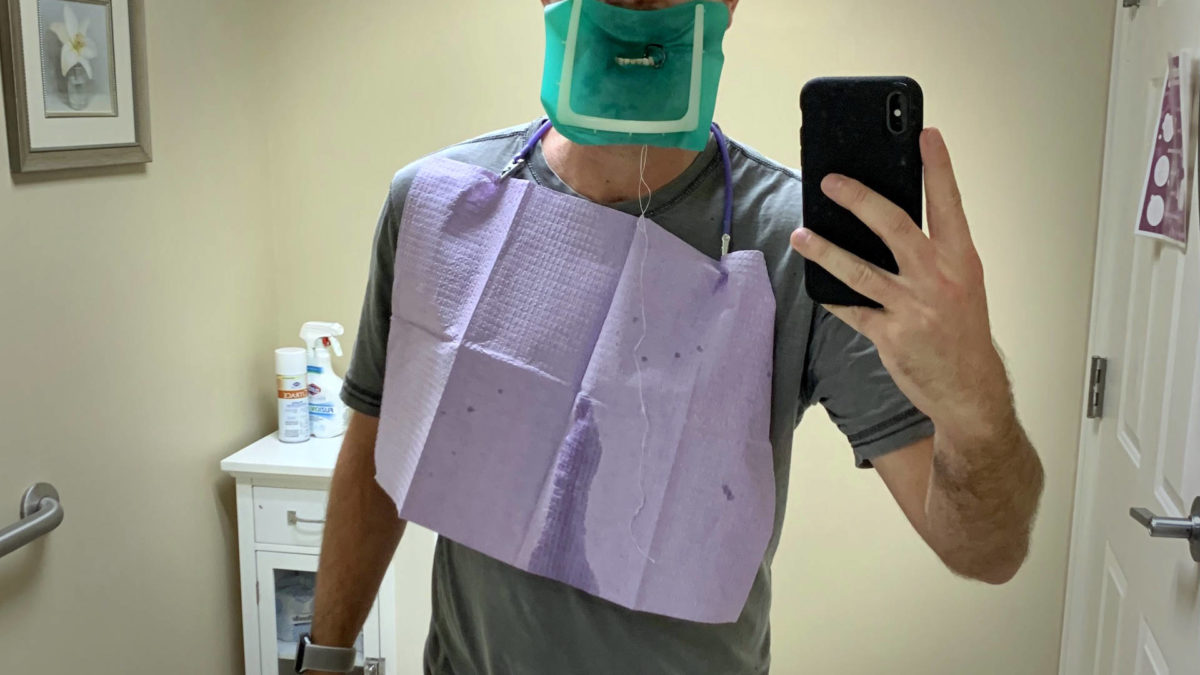“Chris, I can’t tell which tooth it is”, the dentist told me. “Really, it could be all three here that are abscessed—I’m going to refer you to this endodontist”, he continued. The dull aching persisted, but it was replaced in my head with the thought—wait, does that mean three root canals? Holy hell, what is that going to cost?!
I’ll spare you the tense buildup here.
Ultimately, after a full 3D scan of my mouth with that endodontist’s practice, my quote came in at a whopping $3,585.
Plus $185 for that cool scan and a chunk more for the diagnosis.
So, what’s an early retiree to do when faced with dropping a solid month of their FIRE budget on a single dental problem?
Let me lead you down my path of research and analysis that ended with me cutting that cost by about half while still getting the same care. I’ll also reveal several potential dental expense traps that fellow FIRE folks might face.
Dental Coverage Risks
First off, individual dental insurance in the United States sucks. It’s filled with gotchas and sneaky ways to avoid covering care.
It reminds me so much of how individual health insurance used to work when I was hunting for it back around 2007 when I started my first business.
Dental insurance gotchas
Remember how health insurance companies used to avoid covering “pre-existing conditions” and had ridiculous maximum lifetime payouts?
Yeah, it’s a lot like that.
Dental insurance has its own variants like:
Maximum payouts per year.
Dental insurance companies often cap how much they’ll pay towards any covered care per year. And these caps are surprisingly low considering the cost of care. We’re talking $1,000-2,000 being quite common.
Waiting periods for covered care.
Reminiscent of pre-existing condition clauses, dental insurance companies employ waiting periods before they’ll cover certain types of care. That seems to apply most often to non-preventative care. So think: root canals, crowns, etc. The expensive stuff.
Whether you’re shopping for dental insurance or simply plotting your way to FIRE, you should understand what financial risks are involved with your dental care.
On top of the dental insurance specific risks mentioned above, dental coverage shares several risk elements in common with standard health insurance.
These will look familiar to you if you’ve shopped on the ACA for a health insurance plan or had to choose from different plans available from your employer.
Here are some of the top pitfalls:
- Limited coverage: Many dental insurance plans have limits on the amount they will cover for specific treatments.
- High out-of-pocket costs: Even with insurance, patients often have to pay a significant portion of the costs themselves, through deductibles, copays, or coinsurance.
- Narrow network: Some dental insurance plans have a narrow network of participating dentists, limiting the options for patients seeking care.
- Pre-existing condition exclusions: Some dental insurance plans will not cover treatments for pre-existing conditions, such as cavities or gum disease.
- No coverage for cosmetic procedures: Many dental insurance plans do not cover cosmetic procedures, such as teeth whitening or veneers, even though these are common dental needs.
- Administrative hassle: The process of obtaining coverage and reimbursement from dental insurance can be time-consuming and complicated, causing frustration for patients and providers alike.
On top of these specific elements, the cost of dental insurance and dental care in the US has been rising steadily over the years.
In the United States, we have a variety of different types of health insurance plans. These different plan types carry a variety of exclusions, like those mentioned above.
Selecting a plan type that matches your needs helps prevent any dental cost surprises. Let me summarize those plan types.
Choosing the Right Plan
Generally speaking, the different dental insurance plan types are very similar to those offered in the health insurance world. Typically, you’re trading off flexibility in selecting your provider with level of care.
In other words, selecting a plan that lets you visit a variety of dentists and specialists like endodontists or periodontists means higher cost care at those specialists.
More options, higher costs. Fewer options with your primary dentist acting as a gatekeeper to the specialists through referrals means lower overall costs.
Common types of dental insurance plans
Below are the five generally available types of plans common in the US:
- Dental Health Maintenance Organizations (DHMOs): DHMOs are a type of managed care plan that provides dental services at a lower cost in exchange for using a network of providers. DHMOs usually require you to choose a primary care dentist from their network and get prior approval for certain procedures.
- Preferred Provider Organizations (PPOs): PPOs offer a network of providers, but also allow you to see out-of-network providers at a higher cost. PPOs typically offer more flexibility than DHMOs, but also tend to be more expensive.
- Indemnity Plans: Indemnity plans provide you with more flexibility to choose your own dentist and get treatment when you need it. However, indemnity plans typically have higher out-of-pocket costs and may have more limitations on coverage.
- Discount Dental Plans: Discount dental plans are not insurance plans, but instead offer discounts on dental services in exchange for an annual fee. Discount dental plans typically have a more limited network of providers and may not cover all types of dental procedures.
- Dental Savings Plans: Dental savings plans are similar to discount dental plans in that they offer discounts on dental services in exchange for an annual fee. Dental savings plans typically offer discounts on a wider range of services than discount dental plans and may not require you to choose from a specific network of providers.
Of course, the devil is in the details. You’ll want to read through all the fine print with whichever plan you choose.
It’s difficult to make a blanket statement that those on the path to FIRE would prefer one type of plan over another.
It really depends on both where you are on that path and your overall dental health.
My plan type decision
At this point in my personal FIRE journey, I’ve trended toward more defensive decisions.
Building wealth is no longer my goal. Defending it is.
For that reason, I’ve looked to greater levels of coverage in areas where I know I have higher risks in recent years.
But, I am not the same person I was yesterday. Or some years before. And not long ago, I was still building wealth.
Unfortunately, my dental insurance choices were still stuck in a mentality of higher risk and wealth building.
I’ve been paying about $20 per month for an insurance plan that was primarily for preventative care.
But I need more than just preventative care.
You see, throughout my life, I’ve had pretty routine dental problems and needs. And they’ve only gotten worse, recently.
Had I properly reevaluated my dental insurance choices within the past few years, I would have elected a higher level of coverage.
But, I was lazy and didn’t. Now that’s bitten me in the butt to the tune of thousands of dollars as I highlighted in our recent monthly budget.
Don’t be like me!
Adjust your offensive and defensive financial self as you mature through your FIRE journey.
Even though this problem could have been avoided in the first place, let’s take a look at my personal experience and see what I did to cut my dental bill roughly in half while still getting the same level of care from the same provider.
Cutting a Dental Bill in Half
I think that folks on the path to financial independence often do a good job of taking into account the potential costs of healthcare.
We figure it into our retirement projections, even as variable as it is, and set proper expectations.
But, we often miss the potential for massive dental costs.
I know I’ve done so.
I recently shared how the dental costs central to this post created a financial challenge for our monthly budget. This is the sort of problem that could normally mean choosing between making mortgage payments or taking care of your health.
So what’s a financially independent person to do with plenty of time on their hands? Well, the answer is: endlessly research solutions on how to reduce a nearly $3,600 dental procedure estimate to something more palatable.
But first, let me summarize the top tips to avoid this sort of a thing in the future.
Preventative saving on dental care
In my research, I came across many options to avoid the sort of massive dental cost I’ve experienced in the first place.
- Regular preventive care: Regular dental cleanings and check-ups can help prevent more serious and expensive dental problems from developing. Floss, brush, and visit the dentist regularly!
- Comparison shopping: Comparing prices from different dentists for the same procedure can help you find the best value for your money. I asked for estimates from multiple nearby dentists and they came in close to the same rate. Note: your dental insurance network (even if not a “covered procedure”) can make a huge difference in the rate!
- Negotiating with the dentist: Some dentists may be willing to negotiate their fees or offer discounts for cash payment or in exchange for referrals. For me, the cash rate was the same.
- Utilizing community resources: Some communities have low-cost or free dental clinics for those in need, especially for those who are uninsured.
- Using flex spending accounts: If your employer offers a flexible spending account, you may be able to use pre-tax dollars to pay for dental expenses. They’re not just for traditional healthcare!
- Dental schools: Dental schools often offer low-cost dental care through supervised student clinics. Our nearby dental school was an option for me, but unfortunately the lead time was measured in months!
Remember, it is important to prioritize your dental health and not compromise on quality care. While saving money is important, compromising on your dental health may lead to more expensive problems in the future.
A bottle of whiskey and some pliers was never a real solution!
So what about having the procedure done somewhere else entirely?
Dental tourism
Like with traditional healthcare, dental tourism has been growing around the globe as high-cost areas seek to obtain services from lower cost ones.
In the US, many folks flee across the southern boarder for their dental care. It’s incredibly common along the Mexican boarder to find dental shops setup to cater to this need.
I sunk several hours into researching dental tourism.
That’s right, I was inches from hopping a flight to Lisbon—I looked into Cancun, too, but determined Lisbon was a better fit—just to have these root canals done.
The overall cost was going to be about the same but included a roundtrip ticket to a destination I’ve grown to adore. So what’s not to love?
One issue for me was the unknowns. I was confident in my local dentist’s recommendation and wanted to be able to return to the endodontist if any issues persisted.
But the key reason was that I found a different solution to dramatically cut my bill. Had that not been the case, I’d probably have a post about having dental work completed Portugal published.
How I cut my dental bill dramatically
As you can see from my general tips above, I couldn’t do much to cut my cost of care through dental schools, negotiation, or swapping providers.
So, how’d I save over a thousand bucks on my multiple root canals and still have them done by the same endodontist my dentist referred me to?
Simple.
I purchased dental insurance.
Insurance without a waiting period
That’s right. I managed to hunt down an insurance plan in Virginia that offered coverage for root canals (and other “major services”) that also didn’t have waiting periods.
That was the “big win”—finding a plan that didn’t have a waiting period for covered care. Amongst the dozens of plans I researched, quite literally just one offered both coverage for major services and no waiting period for that coverage.
In-network rates
On top of that, the carrier (Anthem) was “in-network” for my chosen endodontist. My pre-existing preventative-focused dental insurance was out-of-network for this provider.
Being in-network cut the procedure cost by nearly one third! To be in-network, providers must adhere to maximum allowable charges instated by the insurer for procedures. This is before any insurance copayments kick-in.
The final cost
And so, many hours of research led to a simple insurance signup form and short phone call. I pre-paid the monthly bill, which was now around $50 instead of $20, and my insurance would begin the first of the next month (fortunately, only a few days away).
I scheduled my day of root canals on the second of the following month.
The estimate started at $3,585 divided by 3 or about $1,195 per tooth. It fell to about $850/tooth with the in-network rate. The insurance kicked in 30% coverage (which will rise to 40%, and then 50% over the next two years).
That brought the final bill to about $600/tooth or nearly half!
And now, here I am writing to you from Andalusia some months later with three freshly retreated root canals and no pain.
I happily setup autopay on my new insurance a bit ago.
I’m ready to avoid all the same rigamarole for the next dental procedure that’ll inevitably come pricking its way into my mouth.



5 replies on “How I Saved 50% on Dental Bills Without Tourism or Schools”
And thanks to all of Chris’s research, I was able to follow in his lead to cover the costs of a hidden cyst in my jaw just a month later!
3 root canals in your 30s? I think diet and
overall dental hygiene should be the focal point of the article. Prevention rethought as the ultimate economical route.
Jay,
Thanks for stopping by with some insight!
And ha, it’s even worse than that! I mentioned briefly that it was actually 3 retreatments—so this was 3 teeth that had already had root canals done! My first was in my late teens or twenties and the subsequent two over the next decade.
Without going into too much personal detail, my dentist(s) are convinced it’s because of trauma. It’s 3 teeth right next to each other that are always the issue. Fun fun! Prevention in this case might be avoiding the initial trauma which is of course difficult.
Nonetheless, like with your overall health—an exercise habit, greens, etc.—prevention is the far more economical route for these sorts of expenses. You’re absolutely right. Not to mention, you get to avoid the drill!
PS: I was tempted to leave your typo in place that you corrected in the follow up but fixed it directly. I like the idea it brings out though—“dammit man, prevention is the only thing that matters here!”
Your reply which linked dental health to trauma reminded me why I first noticed your blog. It’s an informed, considered and empirically anchored FI blog, yes. But those are within they blogscape not particularly remarkable. What sets your work apart from my perspective is your ability to weaving in a different kind of sensibility into your financial posts. I wouldn’t call it a political positioning but it is certainly a reflexive ethics. You do it sincerely, its not soap boxing nor dogmatic and yet it articulates a particular perspective in an engaging and thoughtful manner. That socratic invitation to think with and question with, I suppose that’s what differentiates your work.
A sincere thanks to you.
Jay,
Thanks again for the thoughtful analysis! Most of all, I hope you’re getting something of value out of your time spent reading and following along with our adventures.
We’ll do our best to keep up the quality. Cheers!